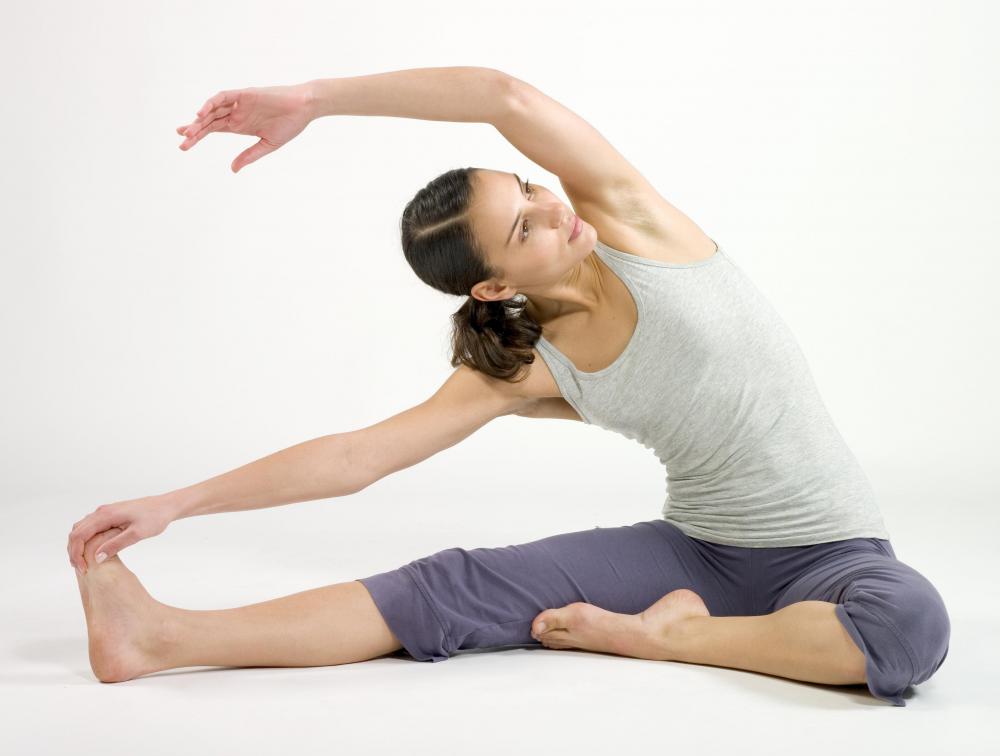At WiseGEEK, we're committed to delivering accurate, trustworthy information. Our expert-authored content is rigorously fact-checked and sourced from credible authorities. Discover how we uphold the highest standards in providing you with reliable knowledge.
What are the Different Types of Stretching Techniques?
To keep the body supple and flexible, different stretching techniques are used to increase muscle length. There are several different stretching techniques including ballistic stretching, PNF stretching and passive stretching. Which one is right for a specific person depends on the situation as they all have different advantages and disadvantages. Generally a passive stretch is the least effective of the different stretching techniques, although it is also the safest. PNF stretches are often considered to be the most effective type of stretch but also involve an increased risk of injury.
Passive stretching is probably the most common type of stretching technique. During a passive stretch the stretcher will get into the stretching position and then hold this for a certain amount of time. Sometimes this is also referred to as static stretching although these exercises have slightly different meanings. With a static stretch the person brings his or her muscle to the point of stretch manually while a passive stretch usually involves another person.

Ballistic stretching is a technique that should usually be avoided. During a passive stretch a position is held for a period of time but a ballistic stretch involves “bouncing” to try and increase the range of motion. This can often cause injury and hence is not advisable without professional supervision. The problem with ballistic stretching is that muscles have an injury prevention system that forces them to actually become tighter when in danger. This reaction is often triggered when someone uses ballistic stretching and hence may be counterproductive as well as dangerous.

PNF stretching can be an effective way of increasing muscle length. PNF stands for proprioceptive neuromuscle facilitation and involves stretching the muscle and then contracting it before stretching again. This allows for far greater flexibility gains in a shorter period of time. Sometimes PNF stretching also involves swinging of the limb in a combination of passive, ballistic and PNF stretching although this is an advanced form of stretching exercise and should generally only be performed by athletes or those under the supervision of a trainer.

The reason that PNF stretching is so effective is that after contraction a muscle is especially vulnerable to being stretched. Using this brief period of time the stretcher can train the muscle to become more flexible. When stretching a muscle using PNF stretching techniques, the person stretching should be careful to avoid over-stretching. If any pain is felt then the stretch should be stopped in a slow and controlled manner. Repeated over-stretching can eventually lead to serious injury and hence should be avoided with any of the stretching techniques.
AS FEATURED ON:
AS FEATURED ON:
















Discussion Comments
@Iluviaporos - I wouldn't suggest learning entirely from books and videos though. It's quite difficult to tell whether or not you're using the proper stretching techniques just by copying books, or looking at yourself in the mirror.
Not only do you not have the experience to know which postures are done correctly and which aren't, you also can't really see all of yourself very well.
I think it's fine to do it at home by yourself, if that's what suits you best, but I also think that everyone should have at least a couple of classes with an instructor who knows what they are doing. Maybe once or twice a year, just to make sure you don't fall into bad practice.
I mean, if you routinely stretch the wrong way you can end up injuring yourself, or shortening your muscles, which is the exact opposite of what you should be aiming for.
@irontoenail - It's a good idea to try and use some relaxation techniques in between a workout and doing yoga, as you aren't supposed to do yoga immediately when you are just finishing with something like a run. I think it's something to do with the fact that yoga has as much to do with breathing as it does with stretching.
I'm more of a fan of Pilates myself, since it incorporates the best of several different techniques, including yoga and it employs a lot of different PNF stretching, which, as it says in the article, is the best kind of stretching you can do in a limited amount of time.
I taught myself how to do some Pilates from the internet and from some different books and videos I've seen over the years, so if you want to do it but don't have time to go to a studio, there are definitely options available.
I didn't realize there were so many different kinds of stretches. The only ones I'd heard of were passive and active stretches, although I guess active stretching is probably not as useful for stretching out the muscles so much as just warming them up for exercise.
In fact, I've heard that the best thing to do before exercise is to warm up and use active stretching, rather than passive stretching as some people think they ought to, because if you use passive stretching (or, presumably the other kinds listed in the article) you'll loosen your muscles up too much and leave them more prone to injury during your workout.
It is a good idea to use the passive stretching after the workout though as it can help to prevent stiffness and soreness, particularly if you pushed yourself harder than usual.
I personally use some yoga techniques after my workout and I find it makes me feel much more lively afterwards.
Post your comments